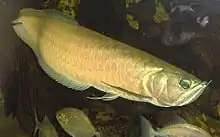Silver arowana
The silver arowana (Osteoglossum bicirrhosum) is a South American freshwater bony fish of the family Osteoglossidae. Silver arowanas are sometimes kept in aquariums, but they are predatory and require a very large tank.[1]
| Silver arowana | |
|---|---|
 | |
| Scientific classification | |
| Kingdom: | Animalia |
| Phylum: | Chordata |
| Class: | Actinopterygii |
| Order: | Osteoglossiformes |
| Family: | Osteoglossidae |
| Genus: | Osteoglossum |
| Species: | O. bicirrhosum |
| Binomial name | |
| Osteoglossum bicirrhosum | |
The generic name Osteoglossum means "bone-tongued" and the specific name bicirrhosum means "two barbels" (from the Greek language).
Range and habitat
This South American species is native to the Amazon, Essequibo and Oyapock basins.[2][3] It is absent from the Rio Negro basin, except the Branco River, which is inhabited by both silver and black arowanas.[3]
The silver arowana occurs in both black- and whitewater habitats, including flooded forests.[1][4]
Description
This fish has relatively large scales, a long body, and a tapered tail, with the dorsal and anal fins extending all the way to the small caudal fin, with which they are nearly fused. Its maximum total length is typically considered to be 0.9 m (3.0 ft),[2] but there are reports of individuals up to 1.2 m (3.9 ft).[1] Unlike the black arowana, the silver arowana has the same coloring throughout its lifespan. Adults of the two species are very similar, but can be separated by meristics.[5]
Arowanas are sometimes called 'dragon fish' by aquarists because their shiny, armor-like scales and double barbels are reminiscent of descriptions of dragons in East Asian folklore.
Behavior
The species is also called 'monkey fish' because of its ability to jump out of the water and capture its prey. It usually swims near the water surface waiting for potential prey. Although specimens have been found with the remains of birds, bats,[6] mice,[7] and snakes in their stomachs, its main diet consists of crustaceans, insects, smaller fish, and other animals that float on the water surface, which its drawbridge-like mouth is exclusively adapted for feeding on.
Conservation status
The silver arowana is currently not listed on any CITES appendix [8] nor on the 2004 IUCN Red List.[9] It is one of the most popular ornamental fish from South America, however, and therefore its conservation status merits attention.[10]
As reported by Environment News Service in August 2005, shared use of the silver arowana population was a cause for a dispute between Brazilian and Colombian authorities. Juvenile silver arowanas are caught in Colombia for sale as aquarium fish, while the people of Brazilian Amazonia catch adult fish for food. A sharp drop in the number of arowanas had caused Brazilian authorities to prohibit fishing of them between September 1 and November 15; the Colombians would prohibit capturing them between November 1 and March 15.[11]
The silver arowana is often kept as a pet by experienced aquarists, being considered an accessible substitute for the Asian arowana, which is listed on CITES Appendix I and is therefore difficult and expensive to obtain legally.
See also
References
| Wikimedia Commons has media related to Silver arowana. |
- Hill, N. (13 June 2016). "Predators: South American Arowana". Practical Fishkeeping. Retrieved 25 October 2017.CS1 maint: uses authors parameter (link)
- Froese, Rainer and Pauly, Daniel, eds. (2017). "Osteoglossum bicirrhosum" in FishBase. October 2017 version.
- Escobar; Farias; Taphorn; Landines; Hrbek (2013). "Molecular diagnosis of the arowanas Osteoglossum ferreirai Kanazawa, 1966 and O. bicirrhossum (Cuvier, 1829) from the Orinoco and Amazon River basins". Neotrop. Ichthyol. 11 (2): 335–340. doi:10.1590/S1679-62252013000200011.
- Saint-Paul; Zuanon; Correa; García; Fabré; Berger; Junk (2000). "Fish communities in central Amazonian white-and blackwater floodplains". Environmental Biology of Fishes. 57 (3): 235–250. doi:10.1023/a:1007699130333.
- Schofield, P.J.; L.G. Nico; P.L. Fuller; W.F. Loftus; M. Neilson (6 August 2013). "Osteoglossum bicirrhosum". U.S. Geological Survey, Nonindigenous Aquatic Species Database. Retrieved 25 October 2017.
- Mikula P (2015). "Fish and amphibians as bat predators". European Journal of Ecology. 1 (1): 71–80. doi:10.1515/eje-2015-0010.
- Julia Tovar Verba; Manoela Lima de Oliveira Borges; Maria Nazareth Ferreira da Silva; Lorena Costa Pinto; José Gurgel Rabello Neto (2018). "Mice on menu: opportunistic feeding behaviour of the Amazonian silver arowana Osteoglossum bicirrhosum". Journal of Fish Biology. 93 (1). doi:10.1111/jfb.13665.
- CITES Appendices
- IUCN Red List
- International meeting on ornamental fish boosts regional conservation and sustainable resource management initiatives (WWF)
- Brazil, Colombia at Odds Over Silver Amazon Fish. A meeting between the representatives of the Amazon Basin countries in August 2005 was meant to discuss the dispute.
- "Osteoglossum bicirrhosum". Integrated Taxonomic Information System. Retrieved 19 March 2006.